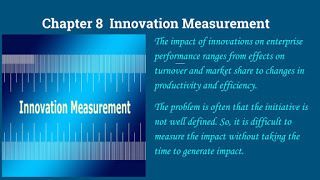The New Book “Unpuzzling Innovation” Introduction Chapter 8 Innovation Measurement
 Innovation is about how to implement the creative idea and achieve its business value. It is the management discipline. Peter Drucker, the modern management guru, was credited as saying, “We can only manage what we measure.” It is also true for innovation management. Innovation measurement and tools can help companies think systematically about business innovation and improve its success rate to meet the business’s expectations.
Innovation is about how to implement the creative idea and achieve its business value. It is the management discipline. Peter Drucker, the modern management guru, was credited as saying, “We can only manage what we measure.” It is also true for innovation management. Innovation measurement and tools can help companies think systematically about business innovation and improve its success rate to meet the business’s expectations.The measures should be oriented to justify innovations the organization needs: The problem for innovation measurement is often that the initiative is not well defined. Without well-defined goals, you won’t have the effective plan and enough time to generate results. So it is difficult to measure the impact without taking the time to generate impacts. Better look at what the results were prior to implementing the innovation and after. Normally organizations look for KPIs measuring business results generated by innovation efforts. But it takes quite some time for a new innovation drive to produce those measures. One of the solutions is to define process KPIs, which demonstrate the growing capability of the organization deliver more innovation with business impact in the future.
The performance of delivering the ideas is another innovation measurement: Innovation Quotient is the percentage of the total ideas space covered by your products and designs. There are several types of Innovation Quotient to measure different aspects of the quality of ideas. An organization’s innovation performance could be measured in terms of its ability to convert the ideas that enter the “innovation Pipeline” into the desired output, propositions, process improvement, etc. So the innovation performance depends on the quality of the ideas entering it and the organizational mechanics that evaluate and implement the ideas.
 The innovation performance indicators should focus on the business objectives and desired behaviors: The performance indicators are the best tools available for innovation managers that wish to promote continuous innovation within an organization. Before performance indicators are designed, the necessary and complete set of desired behaviors should be clearly established. If performance measures are to have the required impact, all of these behaviors should be assessed effectively. If innovation managers are not prepared yet to understand the difference between fostering creativity and rewarding end results, that is another issue to be dealt with. The fact is that traditional talent management focuses on the performances achieved upon the tangible asses, it ignores in its reporting and rewarding system for the intangible assets and resources which include talents, alertness, vision, innovation capability, etc. It means that they miss out the main drivers of performances. When managing innovation, reward and recognition systems that aim at promoting engagement and creativity are more important.
The innovation performance indicators should focus on the business objectives and desired behaviors: The performance indicators are the best tools available for innovation managers that wish to promote continuous innovation within an organization. Before performance indicators are designed, the necessary and complete set of desired behaviors should be clearly established. If performance measures are to have the required impact, all of these behaviors should be assessed effectively. If innovation managers are not prepared yet to understand the difference between fostering creativity and rewarding end results, that is another issue to be dealt with. The fact is that traditional talent management focuses on the performances achieved upon the tangible asses, it ignores in its reporting and rewarding system for the intangible assets and resources which include talents, alertness, vision, innovation capability, etc. It means that they miss out the main drivers of performances. When managing innovation, reward and recognition systems that aim at promoting engagement and creativity are more important.Given the dynamic nature of any organization and the complex mix of its resources and business factors, a well-defined standard set of innovation performance metric would need to be considered in better measures of innovation success such as revenue sustainability, customer satisfaction, knowledge accumulation, brand reputation or price elasticity, etc. To put simply, it takes innovation to measure innovation performance.
Follow us at: @Pearl_Zhu
Published on November 30, 2016 22:40
No comments have been added yet.



